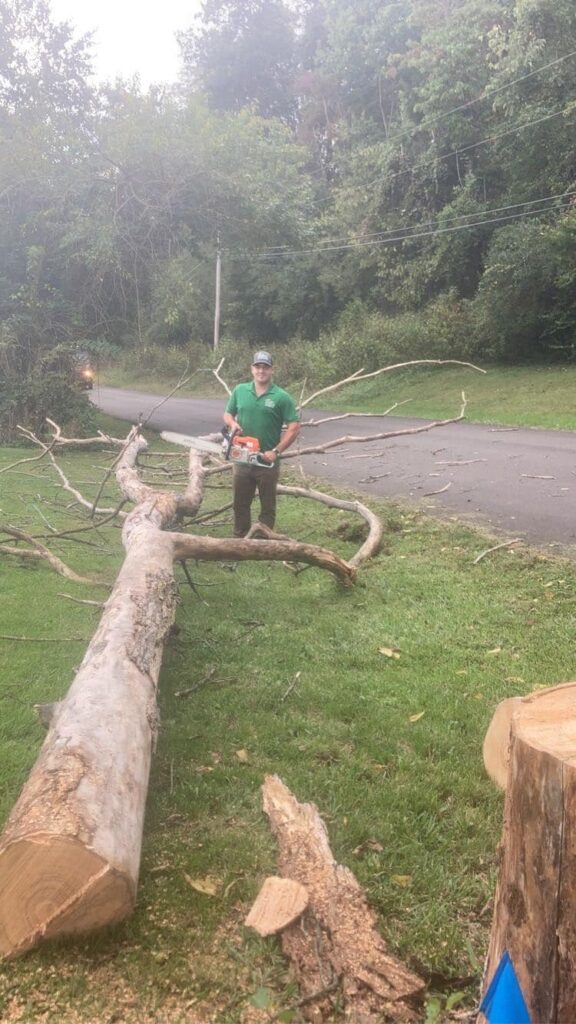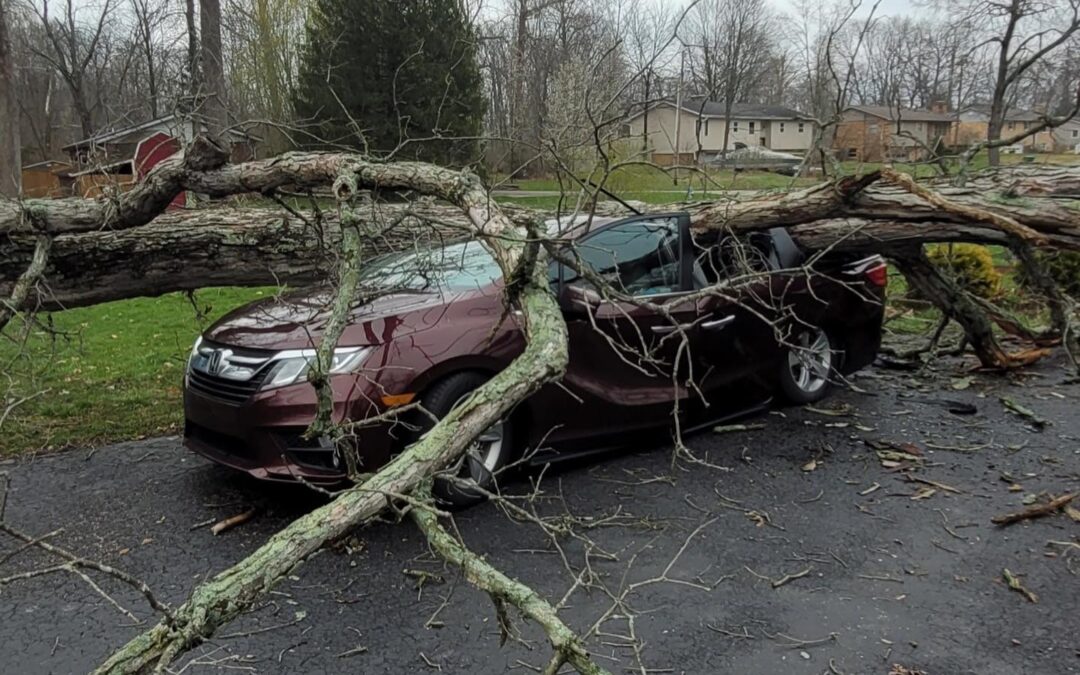With winter right around the corner, Bloomington will likely see a lot of storms including high winds, lightning, and heavy snow. Not only can these storms leave your yard a mess with leaves, twigs, and debris, but they can also damage the trees on your property, potentially posing a safety risk to you and your family.
After a storm, it is crucial that you assess any potential damage to the trees on your property and take steps to repair/remove damaged trees. While you should always consult a professional tree service if you suspect damage to your trees, there are steps that you can take if your tree is damaged by a storm this winter. The fact is that safe and timely intervention is critical if your trees are damaged in a storm, as falling limbs can pose a serious safety hazard.
Keep reading for a look at a step-by-step guide for a safe and effective response if your trees are damaged by a storm in Bloomington, Indiana.
Take Safety Precautions With Storm-Damaged Trees
If you suspect that a tree on your property sustained damage in a storm, it is critical that you proceed with caution. Even after the storm has passed, a damaged tree can still pose a threat. People often make the mistake of assuming that if a tree didn’t fall in the storm, then it will continue to stand. However, damaged trees may continue to fall in the hours/days after a storm.
If your tree has large branches/limbs that are cracked or hanging, or the tree looks unstable in any way, do not go near it. Call a professional tree removal company to have them inspect the tree and assess the damage. Broken limbs may need to be cut, and trees with significant damage may need to be removed.
Before approaching a damaged tree, you should also look around to make sure that there are no fallen power lines or other utility lines that may have been knocked out by the storm. Do not approach any utility lines, as even a phone line can carry voltage and pose a safety threat. Call 911 immediately and alert them that there are downed utility lines on your property.
Assess The Damage
Once you’ve determined that the scene is safe, carefully approach the tree and assess the extent of the damage. Do not stand directly under any branches, as they could fall and injure you. When inspecting your tree, it is important that you distinguish between minor damage that you can handle like small broken branches, and major damage like split trunks, leaning/uprooted trees, and hanging limbs that will likely need to be taken care of by a professional.
Make sure that you take the time to carefully look for signs of damage such as weakly attached branches, significant crown loss, and large wounds that may leave the tree susceptible to disease and insect damage. If you have a tree that sustained significant damage in a storm, it is best to have the damage inspected by a professional tree removal company. The reality is that most homeowners do not know what to look for, and you don’t want to take the risk of having a tree on your property that may lose limbs or even fall onto your house. A professional tree service will have the knowledge and experience to properly assess your tree and help restore it or remove it if necessary.
DIY Tips for Minor Tree Damage
If you are lucky, your tree will only sustain minor damage in a storm such as small broken branches and minor wounds that will heal without threatening the tree’s overall health. To ensure the tree’s health and your family’s safety, remove small broken branches by pruning them at the point where they join larger ones. While pruning damaged branches may cause your tree to look unbalanced, resist the urge to over-prune. Removing too many branches when your tree is already damaged will further threaten its health. Plus, you may be surprised by how quickly your tree will bounce back once dead and damaged limbs have been removed.
If your tree only sustained minor damage in a storm, one of the best things that you can do after pruning damaged branches is to sit back and wait to see what happens. Watch the tree in the weeks following the storm for signs of further damage and disease that may indicate your tree needs to be removed. If your tree only sustained minor damage, it will likely recover quickly without any intervention. Even small wounds (2-3 inches in diameter) will heal over with new bark within a couple of years. If your tree has large wounds, consult a tree service for treatment options, as these wounds could leave your tree susceptible to disease.
If your tree starts to look worse in the coming weeks, you may need to consider having your tree professionally removed.
Major Damage: When to Call a Professional

Of course, if your tree has split limbs, damages to large branches, or is leaning, it is imperative that you consult a professional tree removal service. They have the knowledge, training, and equipment to safely remove dead branches and even the entire tree if necessary. Should something go wrong and your property is damaged during tree removal, they will also have the necessary liability insurance to ensure that you are not held responsible for the damage.
Attempting DIY solutions for severe tree damage is never worth the risk, as attempting to work on damaged trees without the proper expertise can put you and your home at significant risk if a branch falls on you, you lose your balance, or the tree falls unexpectedly.
If a tree on your property has significant damage following a storm, or you are unsure how bad the damage is, your best option is to call a professional to handle the situation for you.
Tree Damage Prevention and Preparation
One of the best things that you can do to prepare your property for future storms is to take steps to prevent potential tree damage this winter. Take the time to inspect your trees this fall to make sure that they are in good health and look for signs of disease or damage. For instance, if you find cavities or decay where branches meet, you may need to have your tree inspected. Additionally, mushrooms growing on the bark of trees or on exposed roots can indicate root rot or wood decay, which can mean tree failure is imminent. Make sure to have your trees professionally inspected if you notice signs of disease, as they may need to be removed in order to ensure your safety this winter.
Perhaps the most important thing that you can do to prepare your trees for winter is to make sure that you prune your trees properly. Regular pruning will help prevent your trees from becoming overgrown, and it will remove dead, damaged, and diseased limbs that could pose a threat in a storm. Consider having this work done professionally, as a tree trimming company will know what branches to remove in order to ensure the health of your trees, and they can provide guidance on whether any trees on your property may need to be removed before winter arrives.
Benefits of Tree Removal
You can also prevent potential property damage during the next storm by preemptively removing trees on your property. As much as you may love the shade and greenery your trees provide, there may come a time when removing damaged/diseased trees is the best option to prevent further damage to your property or other trees. Having your tree removed may also be necessary in order to protect the environment if it is carrying a disease that could spread to nearby trees.
If your property has a lot of trees, having damaged trees removed can have additional benefits such as encouraging environmental diversity. Without a large tree using up so many resources, other plants on your property will have the opportunity to thrive.
Consider having your trees professionally inspected every few years by a tree trimming company who can provide guidance on how to best maintain your trees and whether your property could benefit from having trees removed/replaced.
When their trees are damaged in a storm, homeowners often make the mistake of trying to handle the cleanup themselves. However, this can pose a serious safety risk, as most homeowners do not have the experience or equipment to safely remove damaged branches and downed trees.
If you have a damaged tree on your property following a storm, consider reaching out to a professional like Anthony’s Tree Removal. Our professionals will ensure that your trees are healthy and do not pose a safety hazard.
Contact us to learn more as well as to schedule a free storm damage assessment.


Recent Comments